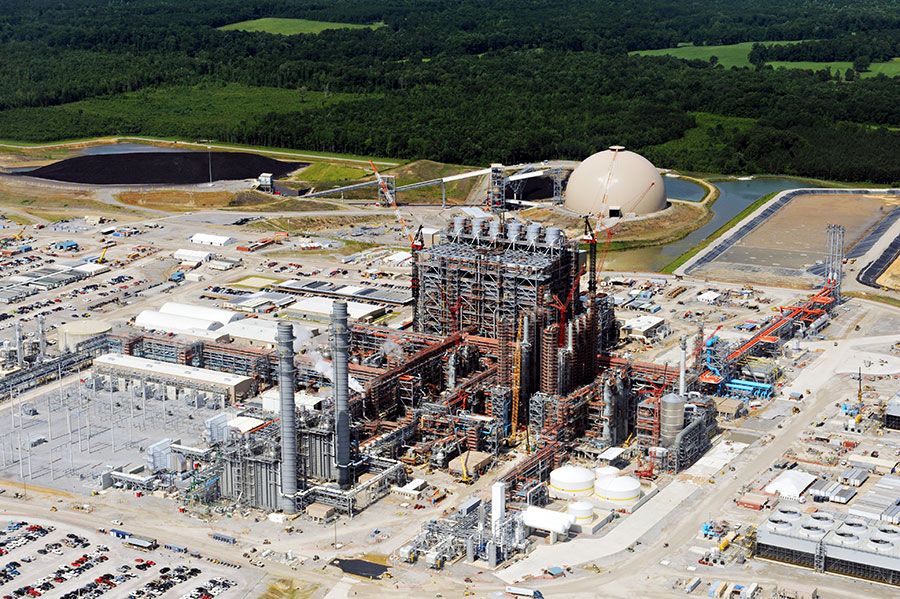By Dan Zegart from Climate Investigations Center
If Donald Trump really wants to get rid of federal corporate welfare, he should be frantically tweeting against a congressional plan that could send billions to the grossly mismanaged Kemper power plant by expanding tax credits for injecting carbon dioxide into oil fields.
These so-called “45Q” tax credits would get richer and could even become a permanent part of the federal tax code depending on which of three bills now being considered by Congress becomes law.
And that could result in the so-called “clean coal” Kemper facility that utility giant Southern Company is building in eastern Mississippi getting between $789 million and $4.5 billion, according to a new report co-authored by Friends of the Earth and Taxpayers for Common Sense — Coal Tax Subsidies: A Boon For Kemper.
“Instead of keeping CO2 out of the atmosphere through permanent underground storage, 45Q has primarily served as a subsidy for oil production,” says the report. “Most of the credits have been claimed for CO2 collected at natural gas processing facilities and then used by oil producers for enhanced oil recovery. Any expansion of the provision would only serve as an additional oil subsidy on top of the billions of dollars in subsidies the industry already receives each year.”
The report also notes another troubling fact – that CO2 leaks from oil fields using enhanced oil recovery, including through carbon dioxide “blow-outs” in which the gas comes blasting out of the ground very much like an oil gusher. At least three of these incidents have taken place in Mississippi and one in Lousiana since 2007.
CO2 gas, which is heavier than air and settles in hollows and near ground level, can fatally suffocate anyone who breathes it in. The Mississippi blow-outs resulted in evacuations of residents and oil field workers.
A blowout in Tinsley Field, near Yazoo City, Mississippi, killed deer, an armadillo, a blue heron and countless birds and other wildlife, while sending one emergency responder to the hospital.
This catastrophic event in August and September of 2011 took 37 days to bring under control at a cost of some $53 million. Specialized equipment and crews had to be brought in from Texas to fight the blow-out, including emergency response teams from companies like Boots & Coots, which worked on the Deepwater Horizon disaster, according to documents from the Mississippi Department of Environmental Quality obtained via a public records request.
But while the frequency of oil field CO2 blowouts is increasing, they are not everyday occurrences.
But the steady hiss of CO2 leakage from oil fields is, according to oil industry insiders.
“CO2 sequestration in oil fields is a myth,” said one Mississippi oil well operator who requested anonymity over fears of economic retaliation. “And it’s not surprising these fields leak like crazy because the oil companies don’t give a damn about that. They just want to get their oil.”
Industry insiders say leaks are pervasive for several reasons. One, CO2 injection is used in older oil fields that often date to the 1930s or 1940s where well equipment is rusty and poorly maintained. And secondly, CO2 is so corrosive, it eats through conventional steel piping.
Only prohibitively expensive nickel-plated steel can withstand the gas. Thirdly, soils in some parts of the country – such as the southeast, including Mississippi – aren’t suitable for CO2 injection.
Says Lukas Ross, a lead author of the new report, CO2 injection is a lousy choice to reduce carbon pollution because even if the CO2 didn’t leak, producing additional carbon-laden oil cancels out any benefits.
“You’re using carbon from a dirty fossil fuel to produce more of another dirty fossil fuel,” said Ross. “Where’s the sense in that?”
While some Mississippians hope that subsidies like the 45Q tax credits could ease the burden of the Kemper plant on local utility customers who may be asked to shoulder $4 billion of the plant’s runaway $7 billion cost – which has risen almost every month from Southern Company original estimate of $2.4 billion in 2010 – the Department of Energy has already given the company more than $400 million, while the state of Mississippi backed $1 billion in bonds, none of which has so far resulted in any reduction of the burden on the utility’s 186,000 rate-payers in southeastern Mississippi, who may see their utility bills double if state regulators give Kemper final approval – an issue that is expected to be settled sometime in 2017.
Southern’s Kemper project has attracted plenty of negative attention from outside of the state. The Securities and Exchange Commission is investigating whether Southern Company deliberately misrepresented when the plant could go on line, charges detailed in July in an in-depth New York Times investigation.
The Times piece appeared after the company illegally fired a whistleblower who charged that company personnel deliberately broke the “logic ties” in software that generates Kemper’s construction schedule to make it look like the plant would go on-line as originally planned in 2014. Southern now admits the plant won’t be in commercial operation until December 31, 2016, but engineers who worked on the plant are betting that that milestone won’t be achieved until mid or late 2017 – if it ever operates successfully.
The Kemper plant is designed to use two huge reactor-like gasifiers to turn low-grade lignite coal into a synthetic gas similar to natural gas, which then operates a turbine to generate electricity, but so far neither gasifier has been able to run for more than a few days, and then only at a fraction of its rated capacity. In the meantime, the plant is operating as a conventional natural gas-fired power plant.
Image credit: Mississippi Power
Subscribe to our newsletter
Stay up to date with DeSmog news and alerts






